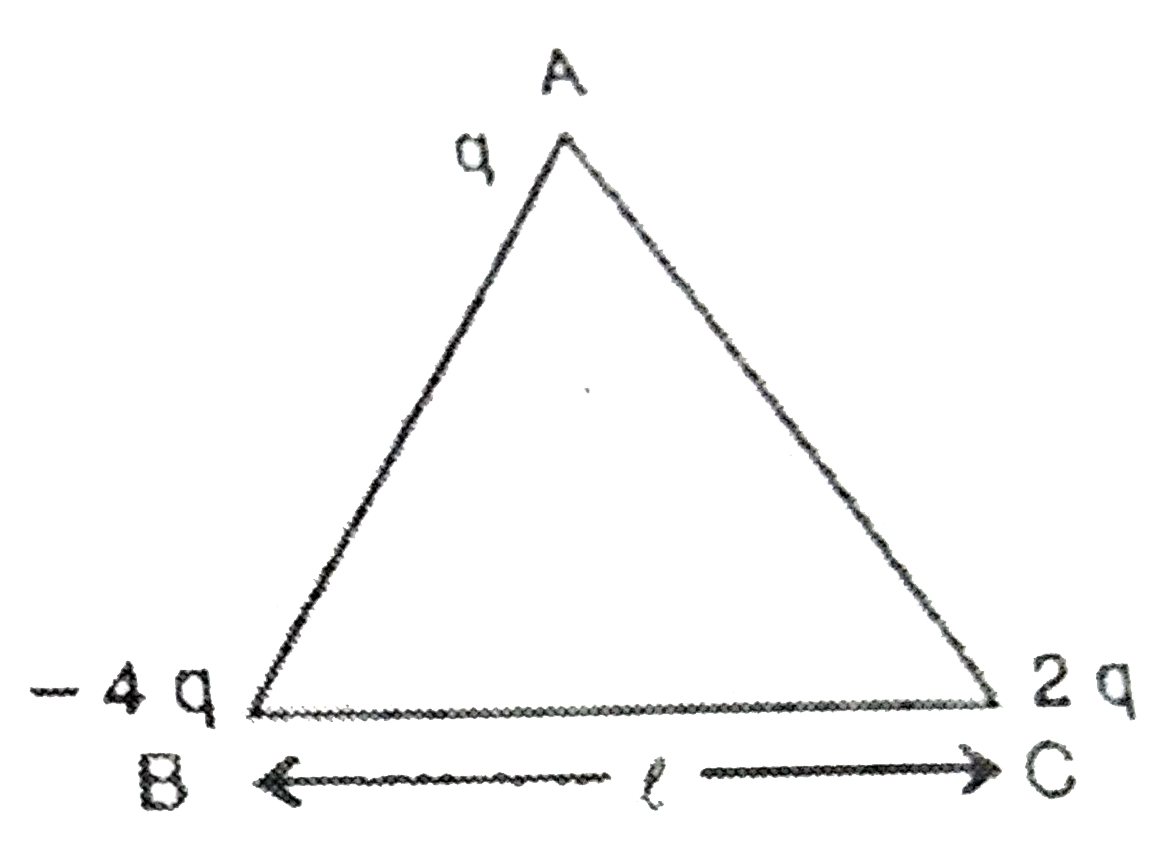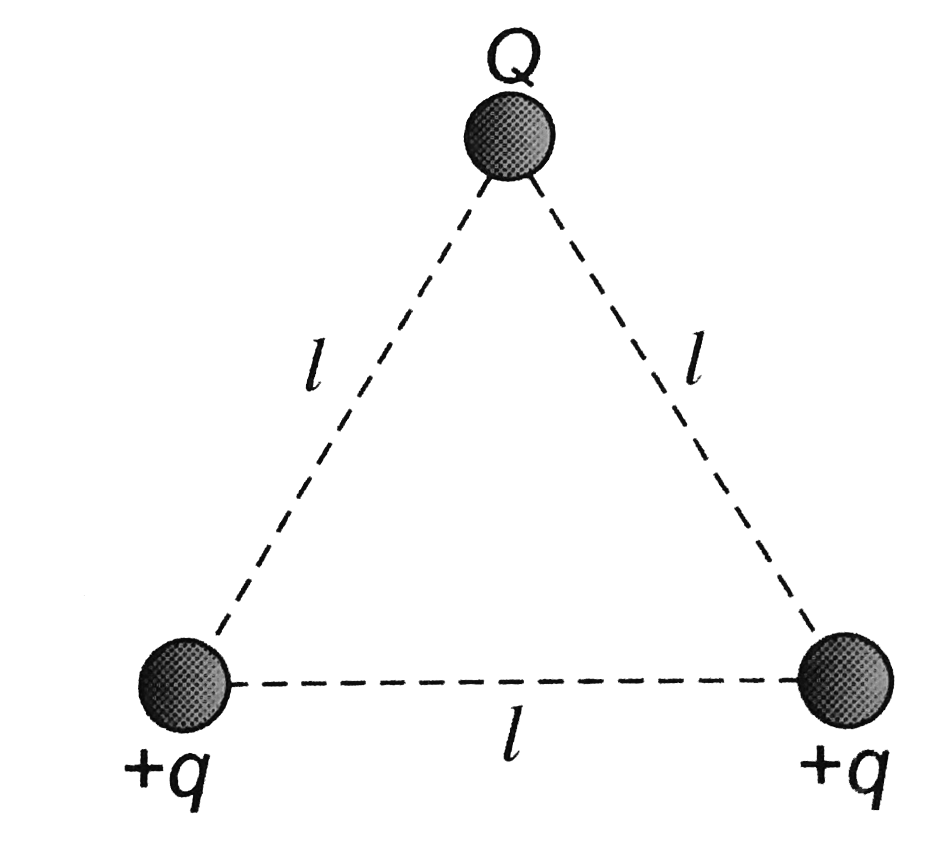Three positive charges of equal magnitude q are placed at the vertics of and equilatral triangle of side l. How can the system of charges be palced in equilibrium?
by placing a charge at the centroid of the triangle
by placing a charge at the centroid of the triangle
by placing a charge at the centroid of the triangle
by placing a charge at the centroid of the triangle
The correct Answer is:A
To solve the problem of placing three positive charges of equal magnitude q at the vertices of an equilateral triangle of side length l in equilibrium, we can follow these steps:
1. Understanding the Configuration:
- We have three positive charges +q located at the vertices A, B, and C of an equilateral triangle.
- The side length of the triangle is l.
2. Identifying Forces:
- Each charge +q experiences repulsive forces due to the other two charges.
- The forces acting on any one charge can be calculated using Coulomb's Law.
3. Calculating the Force Between Charges:
- The force F between any two charges +q separated by a distance l is given by:
F=kq2l2
- Here, k is Coulomb's constant.
4. Resultant Force on One Charge:
- Consider the charge at vertex A. The forces due to charges at B and C can be resolved into components.
- The angle between the lines connecting A to B and A to C is 60∘.
5. Resolving Forces:
- The horizontal components of the forces from charges at B and C will add up, while the vertical components will cancel out.
- The resultant force FR on charge A can be calculated as:
FR=2Fcos(30∘)=2(kq2l2)(√32)=kq2√3l2
6. Introducing a Charge at the Centroid:
- To achieve equilibrium, we need to introduce a charge −q′ at the centroid O of the triangle.
- The centroid O is the point where the medians of the triangle intersect and is located at a distance l√3 from each vertex.
7. Force on Charge at the Centroid:
- The force FO exerted on the charge −q′ at the centroid due to each charge +q is:
FO=kq⋅|q′|(l√3)2=kq⋅|q′|⋅3l2
8. Setting Forces Equal for Equilibrium:
- For the system to be in equilibrium, the resultant force FR on charge A must equal the force FO exerted on the charge at the centroid:
kq2√3l2=kq⋅|q′|⋅3l2
- Canceling k and l2 gives:
q2√3=3|q′|
- Solving for |q′|:
|q′|=q2√33
9. Determining the Sign of the Charge:
- Since we need a charge that attracts the positive charges, q′ must be negative:
q′=−q2√33
Final Answer:
To place the system of charges in equilibrium, a charge of magnitude −q2√33 should be placed at the centroid of the equilateral triangle.
---
- We have three positive charges +q located at the vertices A, B, and C of an equilateral triangle.
- The side length of the triangle is l.
- Each charge +q experiences repulsive forces due to the other two charges.
- The forces acting on any one charge can be calculated using Coulomb's Law.
- The force F between any two charges +q separated by a distance l is given by:
F=kq2l2
- Here, k is Coulomb's constant.
- Consider the charge at vertex A. The forces due to charges at B and C can be resolved into components.
- The angle between the lines connecting A to B and A to C is 60∘.
- The horizontal components of the forces from charges at B and C will add up, while the vertical components will cancel out.
- The resultant force FR on charge A can be calculated as:
FR=2Fcos(30∘)=2(kq2l2)(√32)=kq2√3l2
- To achieve equilibrium, we need to introduce a charge −q′ at the centroid O of the triangle.
- The centroid O is the point where the medians of the triangle intersect and is located at a distance l√3 from each vertex.
- The force FO exerted on the charge −q′ at the centroid due to each charge +q is:
FO=kq⋅|q′|(l√3)2=kq⋅|q′|⋅3l2
- For the system to be in equilibrium, the resultant force FR on charge A must equal the force FO exerted on the charge at the centroid:
kq2√3l2=kq⋅|q′|⋅3l2
- Canceling k and l2 gives:
q2√3=3|q′|
- Solving for |q′|:
|q′|=q2√33
- Since we need a charge that attracts the positive charges, q′ must be negative:
q′=−q2√33
To place the system of charges in equilibrium, a charge of magnitude −q2√33 should be placed at the centroid of the equilateral triangle.
Topper's Solved these Questions
- COULOMB LAW AND ELECTRIC FIELDBook:CENGAGE PHYSICS ENGLISHChapter:COULOMB LAW AND ELECTRIC FIELDExercise:Multiple Correct
Explore 8 Videos
- COULOMB LAW AND ELECTRIC FIELDBook:CENGAGE PHYSICS ENGLISHChapter:COULOMB LAW AND ELECTRIC FIELDExercise:Comprehension
Explore 25 Videos
- COULOMB LAW AND ELECTRIC FIELDBook:CENGAGE PHYSICS ENGLISHChapter:COULOMB LAW AND ELECTRIC FIELDExercise:Subjective
Explore 32 Videos
- CENGAGE PHYSICS DPPBook:CENGAGE PHYSICS ENGLISHChapter:CENGAGE PHYSICS DPPExercise:subjective type
Explore 51 Videos
- ELECTRIC CURRENT & CIRCUITSBook:CENGAGE PHYSICS ENGLISHChapter:ELECTRIC CURRENT & CIRCUITSExercise:Kirchhoff s law and simple circuits
Explore 15 Videos
Similar Questions
Knowledge Check
Consider the charges q,q and -q placed at the vertices of an equilateral triangle of each side l. What is the force on each charge ?
Aq24√2πε0l2B−q24πε0l2Cq24πε0l2Dzero
Three charges 2q,−q,and−q are located at the vertices of an equilateral triangle. At the center of the triangle,
View Solution(a) Three point charges q,-4q and 2q are placed at the vertices of an equilateral triangle ABC of side 'l' as shown in the figure. Obtain the expression for the magnitude of the resultant electric force acting on the charge q.
(b) Find out the amount of the work 4one to separate the charges at infinite distance.

View SolutionThree point charges q are placed at three vertices of an equilateral triangle of side a. Find magnitude of electric force on any charge due to the other two.
View SolutionEqual charges q are placed at the vertices A and B of an equilatral triangle ABC of side a. The magnitude of electric field at the point C is
View SolutionThree particles of equal mass 'm' are situated at the vertices of an equilateral triangle of side L. The work done in increasing the side of the triangle to 2L is
View SolutionThree charges Q,(+q) and (+q) are placed at the vertices of an equilateral triangle of side l as shown in the figure. It the net electrostatic energy of the system is zero, then Q is equal to

View SolutionThree charges Q,(+q) and (+q) are placed at the vertices of an equilateral triangle of side l as shown in the figure. It the net electrostatic energy of the system is zero, then Q is equal to

View Solution